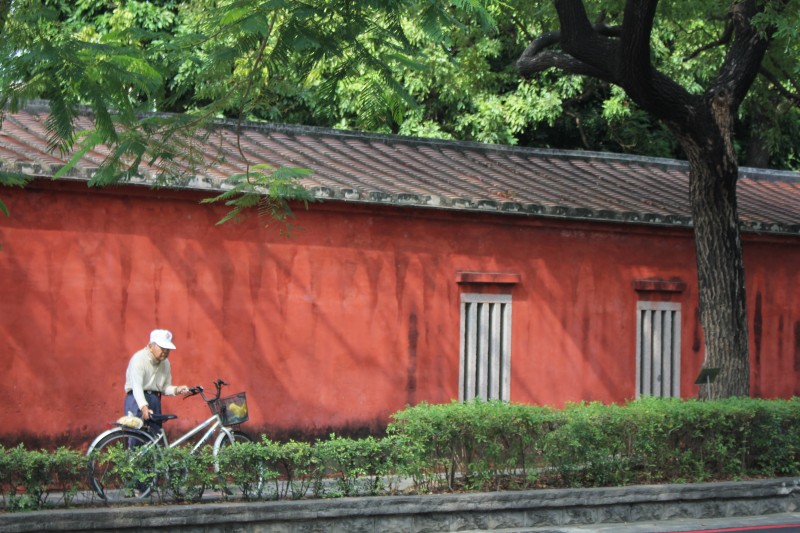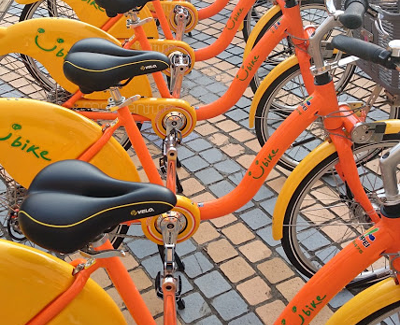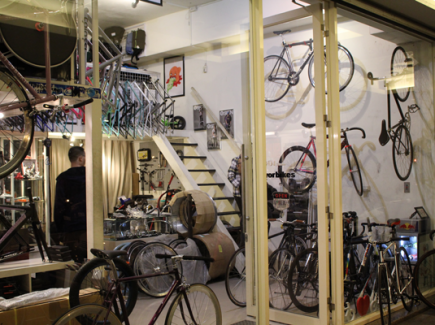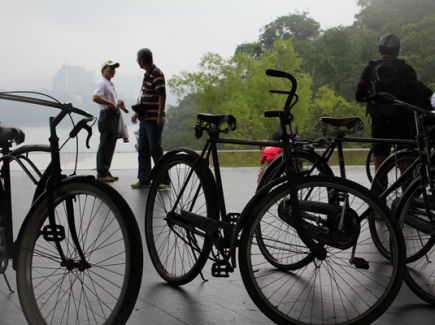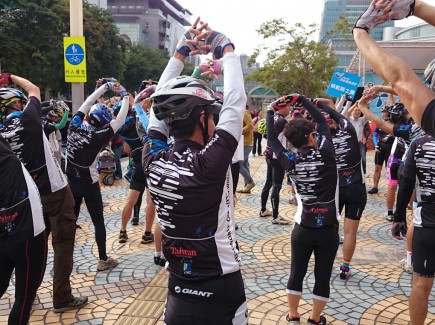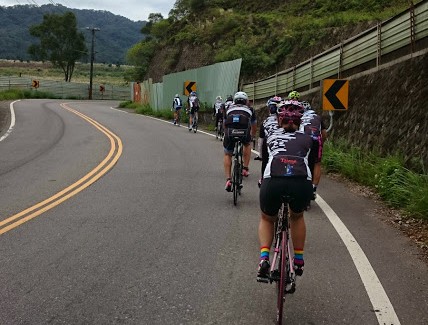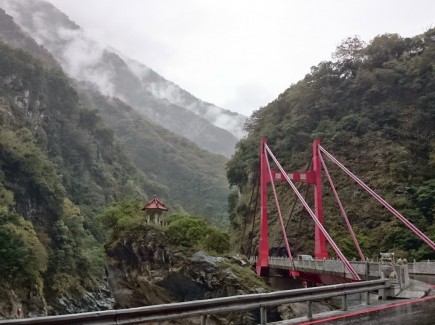Offering outstanding scenery, a tropical climate and spectacular roads, Taiwan is the surprising little island with the lot. Words and photography by Iain Treloar.
It’s 6am, Saturday, and Taipei is waking up. Outside my hotel window, it’s a 180 degree panorama of skyscrapers, high-density apartment towers, hotels and billboards; lush green mountains wallpaper the gaps between. Fourteen floors down, the first early bike riders roll along the still-calm streets. I’ve just finished clumsily putting my bike together after a red-eye flight, and will soon be joining them. I snatch a couple of croissants from the breakfast buffet, click-clack my way through the foyer and, with the whoosh of rubber on tarmac in my ears, I’m finding my way through the unfamiliar streets of Taiwan’s capital.
It’s the first day of the Taiwan Cycling Festival, a week-long celebration of bike-riding, and I’m fortunate enough to have been invited along to see what all the fuss is about.
Taiwan—also known as the Republic of China or Chinese Taipei, depending on who’s asking—is a small island located east of the Chinese coast. It’s a country with a rich history, a strong sense of national identity, and, thanks to its technological capabilities, is the 19th largest economy in the world. Not bad for an island of ambiguous sovereignty that’s just half the size of Tasmania, housing as many people as Australia. But whilst these statistics would seem to imply congestion, urban sprawl and pollution, the island is surprisingly rich in vegetation and conceals its industrial side well.
That industrial side has more relevance to bike riders than you might expect. Taiwan is a titan of the cycling industry, and home to many of the largest manufacturers in the world. China has the edge in sheer numbers, but that’s largely in the low-end; if you’re riding a big brand bike bought from a bike store, chances are it’s a product of Taiwan.
Taiwan has been taking great strides—both domestically and internationally—to highlight the appeal of the country as a bike-riding destination, not just a manufacturing hotspot. Taiwan Cycling Festival is just one initiative to change this perception. The catalyst for the festival was a discussion between the head of Taiwan’s traffic department and Tony Lo, the CEO of Giant Bicycles, where the vision of a concerted effort to build Taiwan as a cycling paradise was formed. Taiwan may have been building bikes in their millions, but according to Lo, much of the population remained unenthusiastic about bike riding, and there was a lack of awareness of the island’s potential as a cycling destination internationally.
The eventual result was the creation of a suite of events designed to demonstrate Taiwan’s considerable natural beauty, and entice visitors onto two wheels.
As it turns out, they were onto something; Taiwan has plenty to attract riders, especially if they’re not averse to a bit of climbing. Running down the island’s spine is a string of mountains—more than 200 of them exceeding 3,000m in height—and along the east coast, the dramatic Pacific coast butts right up to this range’s jungle-covered foothills. And because of the island’s compact dimensions and concentrated urban populations, you’re never far away from spectacular roads and superb climbing, even if you base yourself in the capital, Taipei, or any of Taiwan’s other major cities. It’s just a matter of navigating the traffic to get there.
Taipei City—roughly 2.6 million people—is surrounded by New Taipei, which adds another 4 million to the population of the greater urban area. That’s a lot of people, and on a bike it admittedly feels that way, until you acclimatise to the dance of riding with the traffic. At first, there’s a thrilling strangeness; even the traffic lights (horizontal rather than vertical, flashing instead of constant) take some getting used to. Paired with occasionally lax adherence to road rules, this can make it can all a tad daunting. But there’s a secret to survival on the streets of Taiwanese cities—follow the scooters. In built-up areas, these outnumber bikes by a hefty margin and whilst their progress through the streets is at times haphazard and their accompanying whine bothersome, there remains a certain grace to their movement as they surge and weave through the traffic. Taipei’s traffic is an amorphous river, and sometimes you’ve just got to take a deep breath, dive in and surrender yourself to the flow. Once I’d captured a sense of zen in the midst of the traffic instead of trying to force it to bend to my Australian preconceptions, it was all smooth sailing.
If that all sounds a little high-octane, the 100km of shared riverside paths through Taipei offer a tranquil escape from the hustle and bustle. An extensive network of road-width car-free paths lead in and out of the city, offering smooth concrete riding surfaces and a more subdued view of the city’s towers looming overhead. Many of these paths run through a chain of riverside parks; a ride along the Tamsui river took me past basketball courts and soccer pitches, all busy with casual games in progress, while dozens of riders on Taipei’s distinctive orange YouBike share-bikes pottered along—surprisingly often with blonde dachshunds in the baskets.
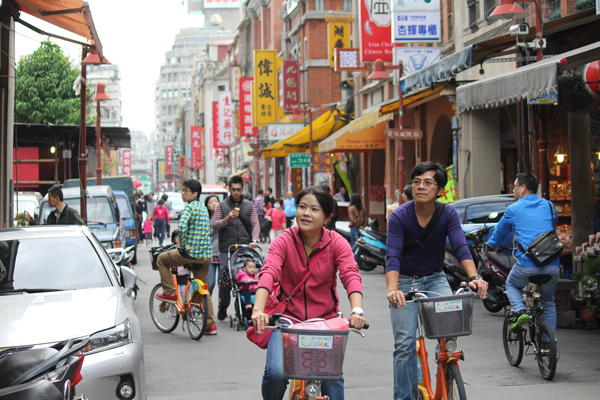 These share-bikes are easy to use and convenient, accepting credit card payment at automated kiosks; however, note that at peak usage demand can outstrip supply. For longer journeys, or city-to-city trips, company-owned Giant stores offer reasonably priced rental bikes, complete with accessories, such as lights and a saddle-bag.
These share-bikes are easy to use and convenient, accepting credit card payment at automated kiosks; however, note that at peak usage demand can outstrip supply. For longer journeys, or city-to-city trips, company-owned Giant stores offer reasonably priced rental bikes, complete with accessories, such as lights and a saddle-bag.
Taipei is circled by mountains in virtually every direction, so if you’re venturing far away from the central bike path network, be prepared to head uphill. One outing took me to the north of the city, climbing up towards Yangminshan National Park and visiting the amazing Ju Ming sculpture museum, not far from the northern coast. On a weekday, the few riders were respectfully passed on the climbs—which often approached 20% gradients—and easily outpaced cars on the same screaming descents.
If hills, share-bikes and traffic are the daily reality of riding in Taipei, the organised events I was here to participate in provide a utopian vision of what cycling could be in the country. The centrepiece of the Taiwan Cycling Festival is the Formosa 900, a nine-day ride circumnavigating the island. Originally this started as a personal challenge for Giant staff, led by elderly company chairman King Liu and CEO Tony Lo, before gradually building in reputation and scale; in 2014 there were hundreds of riders, local and international alike, taking part. Day one, which I participated in, took us from Taipei City Hall, in the shadow of the immense Taipei 101 skyscraper, to Cingjing, west of the city.
There are similarities between mass-participation bike rides in Australia and Taiwan, but some striking differences as well. Group stretching at the start of the day was a nice touch, if a little odd; stranger still was the scheduled 30 minute post-lunch nap. Many of the riders in my group were from various strands of the bicycling industry or business worlds—a Hong Kong-based cycling apparel factory owner, a secretary at Giant, a British trade official—all of whom were eagerly anticipating the nine days ahead. For most, this event was both a major challenge, and one of their most important annual exercise rituals. To accommodate all participants, the ride was undertaken at a pretty relaxed pace, until a punchy little climb just before a rest stop opened up the field and introduced some jostling for position. At each of these regular rest-breaks, the support vehicles dished out bananas, Pocari Sweat (a sports drink) and chocolates. Whilst not the easily packaged cycling food I’m accustomed to, these provided a vital kick to keep going in the muggy conditions.
After tearing down a descent into the nondescript town of Cingjing, I tucked into the first of many communal Taiwanese lunches. The Taiwanese are gracious and generous hosts, and the food on offer—for every meal—is plentiful, served until the table groans under its weight, and usually accompanied by enormous bottles of dull but refreshing Taiwan-brand lager, drunk from tiny glasses.
My appetite sated and thirst quenched, I skipped the obligatory nap, wished luck to my new friends on the rest of their journey around the island, and got whisked away in a mini-van. Much as I’d have loved to keep pedalling, my trip around Taiwan was to be slightly different, for now taking me up to Sun Moon Lake, several hours’ drive away.

This lake, perched in the mountains about two hours’ drive inland from Taichung, is a site of mythical significance to several of Taiwan’s indigenous tribes. Its fame extends to mainland China as well, bringing coachloads of tourists to the area. This lends it a somewhat surreal atmosphere; the undoubtedly magnificent shore of the lake is dotted with narrow-streeted townships and towering hotels, with the slightly neglected ambience of a ski village in summer. I was reminded of the Miyakazi film Spirited Away and, at dusk, with fading light and neon signs starting to flicker on, the sense of dislocation with my surrounds started to catch up. Jetlag, sleep-deprivation, culture-shock or all of the above?
Rising early the next morning for the Sun Moon Lake ComeBike! Day, a mass participation riding event taking in several different routes around the lake, I was feeling a little more with it. The route I was to ride—the Sun Moon Lake Tannan Tribal Village Challenge—is the longest of a number of simultaneously-run courses; counter-intuitively, it doesn’t actually spend that much time around the lake. What I was in for instead was an extended plunge from Xianshan Visitor Centre down off the mountain into the valley, a brisk run along the valley floor for 12km, and a challenging ascent back through the jungle to reclaim all that lost altitude.
Climbing is hard work, but there’s a lot to be said for it as a way of really getting to know the roads. The slower pace gives a fresh perspective on a place very different to home; the sounds and smells are new, and the dappled sunlight filtering through the dense jungle and dangling creepers give the sensation of riding through some distant prehistory. The bunch I’d been sitting in as we went through the valley swiftly split up on the hairpins and oppressive ramps of the climb; it was a matter of self-preservation and riding within one’s limits through the 11km to the top. As I sweated my way uphill, the road passed through an indigenous village, one of several in the Sun Moon Lake area. Although the indigenous population of Taiwan is now quite small—two major waves of migration from the Chinese mainland in the 17th century and post-World War II have reduced them to just 2% of the country’s total—they’re an intriguing link to the island’s past, with a distinct cultural and linguistic identity and closer links to Oceania and South-East Asia than China. Riding through the village, cheered on vigorously by the townspeople on the side of the road, I wondered what they made of these strange lycra-clad intruders into their quiet mountain existence.
Having completed the ascent, with the glory of Sun Moon Lake laid out below me, the road wound around the shore, back up to higher vantage points and down again to busy jetties crowded with tourist boats. The route could fairly be described as ‘undulating’, and by the time the course concluded with a steep climb back to the visitor centre, I was feeling wearier than I’d like to admit. Luckily, there was plenty to distract from my aching quads; toddlers racing balance bikes across the grass with joy writ large across their faces, a pristine collection of vintage road bikes, and Taichung’s trendiest urbanites nonchalantly posing with their single-speeds, all unperturbed by the drizzle that had set in.
After checking out of the hotel and an afternoon exploring Sun Moon Lake by cable-car, bus and boat, it was time to move on. The trip west to Taichung—one of Taiwan’s major manufacturing hubs, and home to numerous major bike manufacturers—was relatively nondescript, until we got snared in a traffic jam. When we finally arrived at our hotel in central Taichung, the endorphins of the ride had worn off, and I wasn’t in the most generous frame of mind to assess Taichung’s merits. Taichung didn’t care much about my low blood-sugar, quickly jolting me out of my funk with a vibrant and prosperous city centre, with parks dotted throughout and a safe, welcoming vibe. Mere minutes of wandering down the park-lined avenue adjacent to my hotel, with excellent buskers playing on several street-corners, and I was quickly engulfed in good spirits that even the worst efforts of Taichung’s premier Italian/Asian fusion restaurant couldn’t quench.
As a bike industry hotspot, Taichung has a sizeable expat community of keen cyclists, with bunch rides heading into the hills surrounding the city most mornings (http://on.fb.me/17yDTJ9). Like most major Taiwanese cities, the streets of the CBD are crowded, but there’s excellent climbing on quiet, challenging roads not far away. For a taste of the riding scene in Taichung, bit.ly/1IZBYsF.
Whilst I’d have loved to spend more time exploring, unfortunately my tight schedule wouldn’t allow it. However, even if you can’t fit a ride in there’s a lot to like about Taichung—including the most decadent ice cream I’ve ever had at a chocolate store called Miyahara. After some visits to bike factories in Taichung’s less comely industrial outskirts we were on the road again. Next stop: Tainan.
Tainan, located on the south-western coast of the island, is the country’s oldest city, with a long colonial history as the seat of the Dutch occupation in the early 17th century. After the Dutch were overthrown, Tainan was the capital of Taiwan for two centuries, before the seat of power shifted north to Taipei. Dotted throughout the city are numerous temples and sites of historical significance, including a spectacularly preserved Dutch fort. But the real star of Tainan—for bike riders, at any rate—is its relative ease of navigation and flat terrain. There’s a limited (7.5km) bike path network threading through a sequence of parks but development is afoot to create a broader network linking historical highlights of the city.
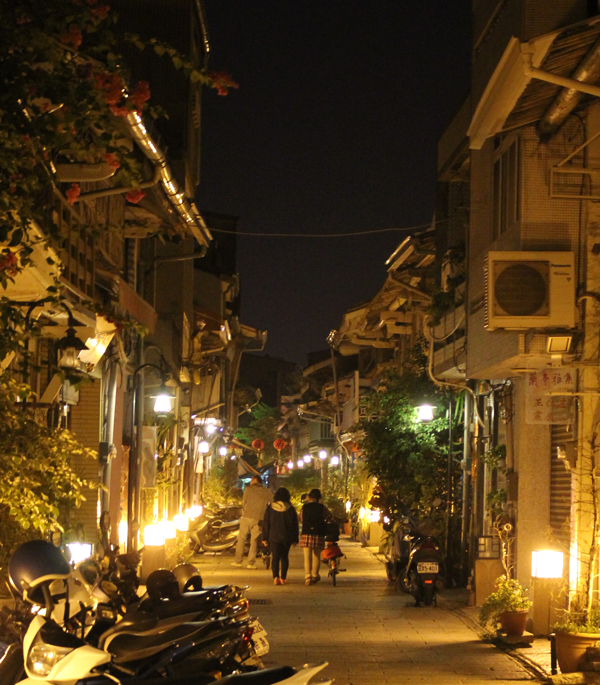
More than any other Taiwanese city that I visited, Tainan felt homely rather than hectic. Away from the main grid of roads, narrow car-free alleyways with two- and three-storey houses and local markets make for a delightful place to explore. One night-time wander through these alleys unearthed friendly bars with decent Belgian beers, art installations and serene temples, glinting gold in the streetlights. Back on the main roads, street-food vendors on the roadside were doing a roaring trade, with locals enjoying the balmy conditions and company of their friends late into the evening. Of course, I didn’t have any friends in Tainan, but after one too many Duvels I really wanted to go and make some, to sit and eat delicious fried things and laugh and talk about how fortunate we all were to be in this pretty city together. But I walked on, people-watching, feeling a fractured mix of at-home and home-sick.
The final event of the Taiwan Bike Festival, the Taiwan KOM Challenge, was to provide the most enduring insight into the island’s cycling scene. After a couple of days back in Taipei, it was onto a high-speed rail service down the east coast to Hualien. The train moved quickly through Taipei’s suburbs, and then, all of a sudden, the city was gone. To the right of the tracks; dramatic, vertiginous peaks covered in thick jungle. To the left; stone beaches, crashing waves and nothing but the Pacific Ocean until Hawaii.
After the excitement of Taipei and Taichung, and the welcoming vibe of Tainan, I found Hualien a difficult place to warm to. It’s a small city, with a population of just over 100,000 people, but has a seemingly endless central precinct lined with flashing neon and identical big brand shops, block after block. I bought some shoes. The same shoes were available on the next corner, and the next, a circuitous Escher painting of Nike stores.
Taiwan is a country of contrasts. Across the island, plumes of incense from shrines drift through street-markets hawking selfie-sticks and iPhone covers; century-old family eateries, with whole geese hanging in their windows, trade around the corner from novelty restaurants called Modern Toilet. If Taiwan walks a line on one front between the old and new, its other nexus is between urbanisation and preservation of the natural environment, and it’s in Hualien where it all converges. The city sits on a coastal plain just a few kilometres across; behind it lies the central mountain range of Taiwan, a string of mist-shrouded, jungle-covered summits stretching the entire length of the island. Hualien city may not be much to write home about, but its surroundings are arguably the most spectacular of the entire country. If there’s a landscape that is quintessentially Taiwan, this is it.
Happily, the powers that be in Hualien aren’t blind to the city’s potential as a base to explore this mountainous wonderland. Excellent cycling paths stretch 15km along the coast; once you’ve escaped the clutches of the city, it’s just you, your bike, jungle and jagged peaks reaching down to the crystalline sea.

It’s those jagged peaks—and the notorious Taiwan KOM Challenge—that have put the east coast on the radar as a road cycling destination. An assembly of international and local competitors of both genders—473 in all, from 28 countries, including Australian pros Tiffany Cromwell and Jo Hogan—tackled the 2014 edition. The race is contested over 105km, from sea level to the summit of Hehuanshan at 3,275m. These altitude figures are impressive enough, but a closer look at the gradients involved is particularly sobering reading; an average gradient on the climb of 7%, with the final 10km in excess of 17% (and occasionally as high as 27%). The route leads through the spectacular Taroko Gorge, a deep-walled marble ravine dotted with waterfalls and shrines, and covered in dense rainforest. After a seemingly endless ascent the race concludes at the summit—and the highest road in Taiwan.
It has been said that the landscape of Taroko Gorge was inspiration for the film Avatar, and that seems to me a pretty good reference. It’s the most dramatic scenery I’ve ever had the privilege of riding through. For anyone that appreciates a serious climb it’s one for the bucket list; for more have a read of a separate Ride On account of the experience of riding in Taroko Gorge.
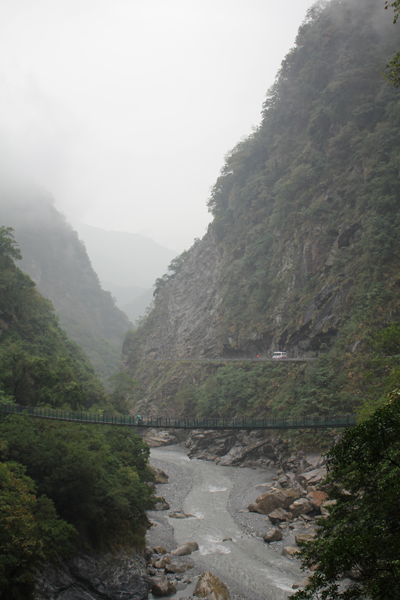 Riding it solo is a very different thing to competing in a race up this most ludicrous of climbs, and from my vantage point in a support vehicle on the Saturday of the race, with the riders setting off at dawn in lashing rain, I was glad to have been able to suffer through this indignity in solitude. By the time our vehicle reached the top of the mountain, just behind the gasping and hypothermic leaders, I’d been witness to four hours of astounding athletic achievement. This event—Taiwan’s closest parallel to Bicycle Network’s own Peaks Challenge—is simply brutal.
Riding it solo is a very different thing to competing in a race up this most ludicrous of climbs, and from my vantage point in a support vehicle on the Saturday of the race, with the riders setting off at dawn in lashing rain, I was glad to have been able to suffer through this indignity in solitude. By the time our vehicle reached the top of the mountain, just behind the gasping and hypothermic leaders, I’d been witness to four hours of astounding athletic achievement. This event—Taiwan’s closest parallel to Bicycle Network’s own Peaks Challenge—is simply brutal.
Winding down the road from the roof of Taiwan, with mist-shrouded mountains stretching off into the distance, I was able to reflect on my experiences over the previous 10 days. At times, it felt like a blur of hotels and highways, but it was the quiet time riding my bike or exploring the back-streets of Taiwan’s cities that would be the indelible memories of my trip. I’d visited five cities, witnessed first-hand the warmth and hospitality of the Taiwanese people, ridden on stunning roads and eaten more different animals in a week than I previously had in my entire life.
For all these reasons and more, Taiwan is an outstanding cycling destination. It’s reasonably close, mostly dodging holiday-thieving jetlag. It’s cheap. The food is incredible, even if sometimes a little challenging to western palates. Its cities are safe and clean, and although navigation isn’t always easy if you don’t speak Mandarin, you can get by. It’s quick to get around, with high speed rail shrinking the distance between any of the major cities to just a couple of hours.
And most importantly, the riding is incredible. There’s an extensive bike path network for leisure riders, covering more than 4,000km around the island—with the intention of forming a complete circuit this year. But even once you’re away from the bike paths or the main cities, the roads are clean, smooth and lead you through endless tropical roads and spectacular scenery.
In a relatively short amount of time, the bicycle has come alive in Taiwan. It’s an important pillar in the country’s push to grow international tourism and, on the evidence of this trip, it’s one that should pay dividends.
For more on visiting Taiwan, see eng.taiwan.net.tw
Ride On’s trip to Taiwan was hosted by Taiwan Tourism Bureau, taiwantourism.org. Their assistance is gratefully acknowledged.
Ride On content is editorially independent, but is supported financially by members of Bicycle Network. If you enjoy our articles and want to support the future publication of high-quality content, please consider helping out by becoming a member.


